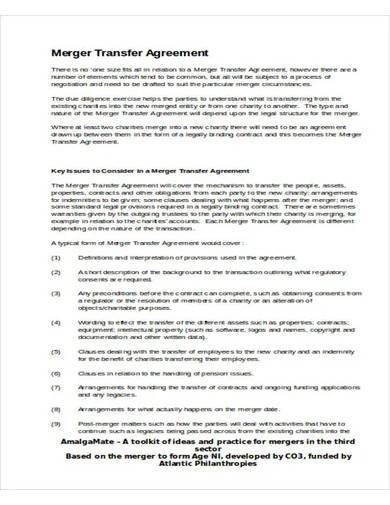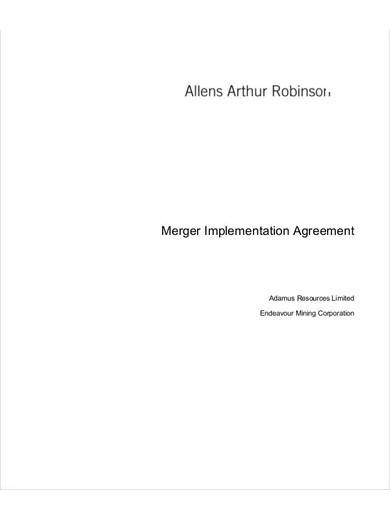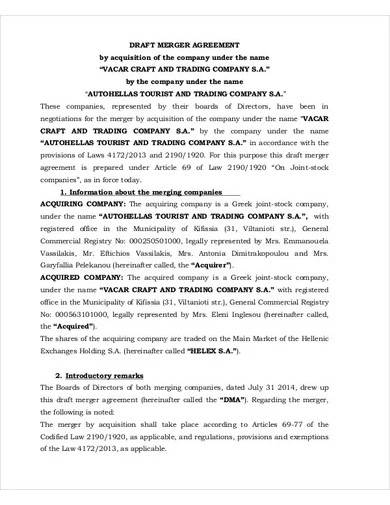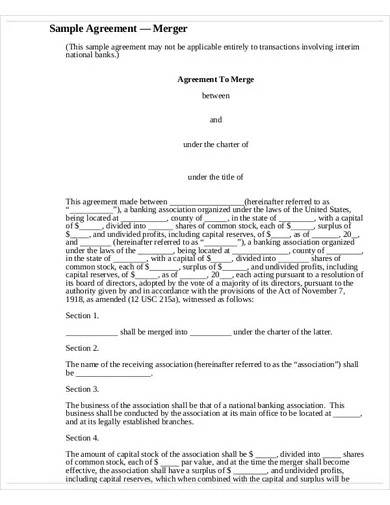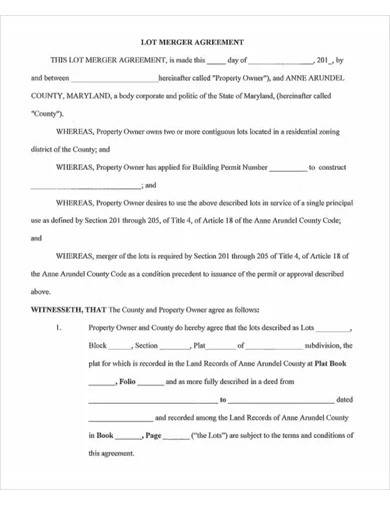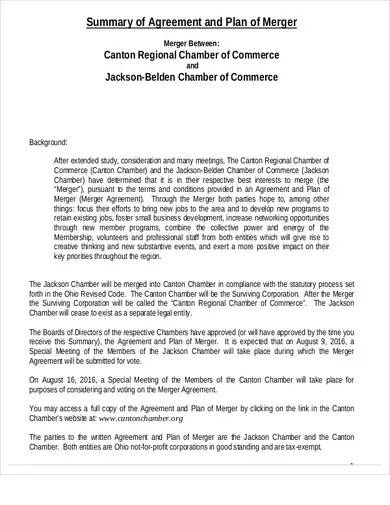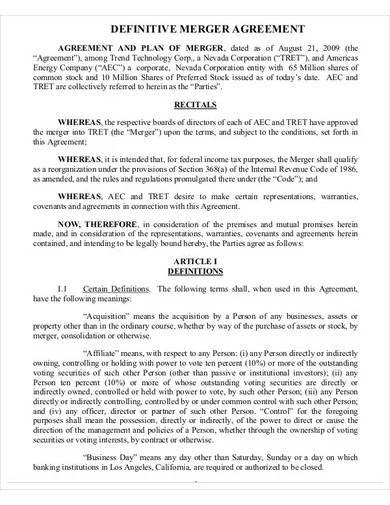Cars (2006), Ratatouille (2007), and Up (2009) are some of the Disney and Pixar merger’s earliest successes since they decided to combine their genius in animation in 2005. Since then, theirs have been known as one of the most successful mergers of all time. Indeed, two is always better than one, unless their foundations sink under the weight of pressure and failed transactions. If you want to ensure that your merger turns out well, you need a merger agreement to clarify all your activity’s terms. This helps all parties involved understand their roles and the underlying responsibilities they need to carry out. Learn more about this below.
FREE 10+ Merger Agreement Samples
1. Merger Agreement Template
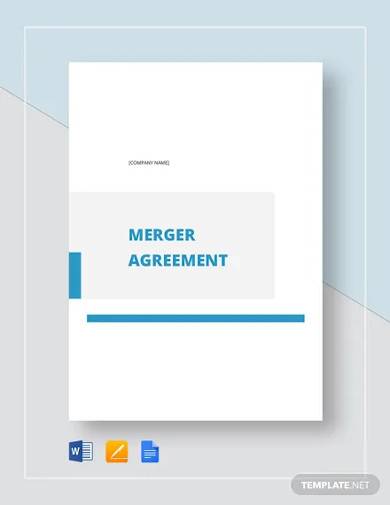
2. Agreement and Plan of Merger Template
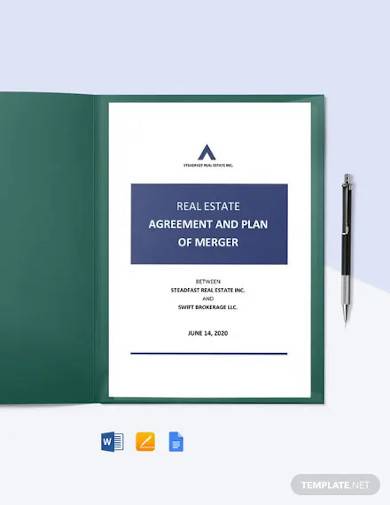
3. Merger Transfer Agreement Template
4. Merger Implementation Agreement
5. Company Merger Agreement
6. Sample Draft Merger Agreement
7. Sample Merger Agreement
8. Sample LOT Merger Agreement
9. Printable Merger Agreement
10. Business Plan & Merger Agreement
11. Sample Definitive Merger Agreement
What Is a Merger Agreement?
A merger is an agreement between companies that plan to unite their names into a single entity. Companies often merge to combine their resources and expand their operations. It helps them achieve their goal plan collectively under a single banner where they can increase their linked shares in the market. It also leads to new opportunities for both companies to extend their territories and boost their revenues. However, this comes with numerous queries and needs clarifications. A merger agreement helps answer all of that with a comprehensive document that answers all terms and matters regarding the companies’ fusion.
Different Types of Mergers
According to Statista, the value of mergers and acquisitions (MA) deals in 2018 rose to $3.9 trillion globally. The United States gathered the highest total at $1.6 trillion. The figures show that mergers and acquisitions worldwide have been continually a success in the industry, despite its many challenges. The face of its success can be seen in the industry’s grand brand names such as Disney and Pixar and JP Morgan and Chase.
To learn more about this, the following are the different types of mergers you should know about:
1. Congeneric merger. A congeneric merger merges two companies that run the same market but differs in certain areas such as production procedure, the technology used, and marketing plan strategies. This is also known as a product extension merger because this usually occurs when a company adds their product line to another company’s product line.
2. Conglomerate merger. A conglomerate merger is the merging of two companies with uncommon activities.
3. Horizontal merger. A horizontal merger combines two industry-related companies. This is common among competing enterprises treading the same business stem to merge and expand their shared market.
4. Vertical merger. A vertical merger combines companies that share a similar supply chain in the industry but at a different level.
5. Market Extension. A market extension merger combines companies that offer the same products or services but to different markets. The goal is to extend its market territory and increase its customer base, consequently boosting its sales report figures.
Tips on Writing a Merger Agreement
If you’ve been looking for ways on how to write a merger agreement, here are some useful tips for you:
1. Discuss All Matters Beforehand
Before you proceed to draft your agreement, all parties should discuss matters concerning the merging of the entities. This helps you write a business agreement with content containing everyone’s take on the situation. This also contributes to making your merger clauses and points as detailed as possible to make interpretation easier. When you have all the details you need from the discussion, begin with an outline draft of your gathered information. Identify the different sections of your agreement and fill in its corresponding details. Your draft makes the actual writing process a breeze because you already have a guide to help you.
2. Specify the Names of the Parties
In a merger agreement, identifying all parties correctly is important. Oftentimes, people pour their attention to the different terms and conditions of their business agreement that they forget that the party’s titles are just as important. Identifying every party involved in the agreement makes it easier to establish accountability. Each varying roles and obligations stipulated in the document must have the corresponding names responsible for them. You should also include the legal names. Without this, it will be hard to resolve future disputes where there’s a need to identify whose roles should be involved and how they can work together to fix the problem.
3. Address Issues Concerning the Shares
Your agreement must tackle the topic concerning the transfer or conversion of shares when the merging occurs. A merger agreement will include a wide array of topic lists, including the structure and management of the company. However, the shareholders are a major concern. Discuss what the shareholder should expect when the merging happens, such as the votation powers, how the executive modifications will affect them, and the options they’re entitled to for their shares.
4. Highlight Company Representations
Allowing your company to be one with another company means not only dipping your feet to their assets but also their liabilities. No one willingly associates themselves to an entity with a questionable background. A company representation reveals the complete account of the company’s profile, including pending lawsuits, debts, operations, and confidential information. This is an important matter to include in the contract before deciding to approve the merger agreement. This ensures that every party knows everything there is to know about their partners.
5. You Can Always Get a Template
A merger agreement can be very detailed and may include a load of information that needs to go into the papers. You can skip all these steps and unburden yourself with a ready-made merger agreement template to help you. It’s complete with all the necessary terms this kind of agreement should have. All you need to do is to customize some parts according to what you’ve discussed with your partners. There’s no need to look into the document structure and the components because a template will have it ready for you.
FAQs
What’s the difference between a merger and an acquisition?
A merger happens when two companies voluntarily join together as a single entity, creating a new organization. On the other hand, an acquisition occurs when a company takes over another company.
What are some of the reasons why companies opt for a merger or acquisition?
Here are some reasons why companies choose a merger or acquisition path:
- Increase share value
- Acquire new assets
- Secure a higher financial scope
- Lower tax liability
What are some of the disadvantages when you undergo a merger or acquisition?
Some of the disadvantages of undergoing a merger or acquisition include:
- Potential increase in prices in the market
- Fewer choice for the consumers
- Employee termination
- Complications due to clashing company culture
A merger allows a company to expand its connections and extend the scope of its operations through another company’s assets and resources. A merging in the industry is a symbol of individual success for every company. However, there’s always the risk of transactions ending badly. A merger agreement aids in smoothening the creases the merger plan so everyone understands what it’s all about, what they need to do, and what are the underlying nuances upon its approval. Go through our collection of merger agreement templates and get yours now!
Related Posts
Sample Business Agreement between Two Parties
FREE 9+ Shop Rental Agreement Samples [ Commercial, Lease, Tenancy ]
FREE 10+ Charter Agreement Samples In MS Word | Google Docs | Apple Pages | PDF
FREE 10+ Mentoring Agreement Samples In MS Word | Apple Pages | PDF
FREE 10+ Partner Agreement Samples In MS Word | Google Docs | Apple Pages | PDF
FREE 10+ Individual Agreement Samples In MS Word | Google Docs | Apple Pages | PDF
FREE 10+ Strategic Agreement Samples In MS Word | Google Docs | Apple Pages | PDF
FREE 10+ Equity Agreement Samples In MS Word | Google Docs | Apple Pages | PDF
FREE 10+ Producer Agreement Samples in MS Word | Apple Pages | PDF
FREE 10+ Grant Agreement Samples In MS Word | Apple Pages | PDF
FREE 8+ Meeting Agreement Samples in MS Word | Google Docs | Apple Pages | PDF
FREE 10+ Community Agreement Samples In MS Word | Google Docs | PDF
FREE 8+ Real Estate Option Agreement Samples in MS Word | PDF
FREE 10+ Call Option Agreement Samples In MS Word | PDF
FREE 10+ Advertising Agreement Samples In MS Word | Google Docs | Apple Pages | PDF

